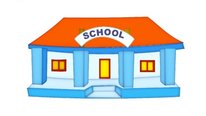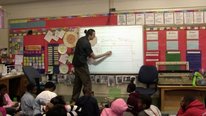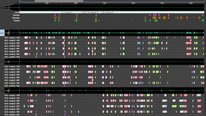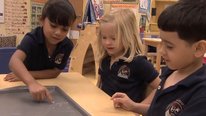NSF Awards: 1250362, 1250802
The goal of Technology for Mathematical Argumentation (TMA) was to construct a computational environment in which elementary students could explore the behavior of arithmetic operations such as multiplication and division. It is based on the work of Russell, Schifter & Bastable (2011), who introduced the idea of representation-based proofs, a way for young students to demonstrate why a generalization is true using a representation rather than algebraic symbols. Our system, Classroom Learning Partner, provides two kinds of tools to support this process: Tools to construct and manipulate mathematical representations, such as arrays, and an animation system to record the transformation of a quantity through an operation. Here, we demonstrate how we designed a curriculum sequence to lead second-grade students to use CLP to explore the generalization: Nx4 = (Nx2)x2.
TMA is a collaboration between TERC and MIT’s Center for Educational Computing Initiatives, now part of MIT’s Office of Digital Learning. This material is based upon work supported by the National Science Foundation under Grant Numbers DRL-1019841 and 1020152. Any opinions, findings, and conclusions or recommendations expressed in this material are those of the authors and do not necessarily reflect the views of the NSF.









Andee Rubin
Senior Scientist
We see the representations we have developed as the tip of an iceberg, beginning answers to the question: what would a digital visual language for indeterminate quantities look like? Because we worked with second graders, they were quick to make observations like “N X 4= (N x 2) x2 only if the N’s are the same,” often reminding us of aspects of generalization and representation that we had taken for granted.
E Paul Goldenberg
Distinguished Scholar
I’d be fascinated to see exactly how kids interact with this. Do you have links to any videos that show this interaction? If not, can you briefly describe what steps in interactions lead to kids’ generalizations? It looked like the software environment did much more than replace, with greater precision and ease, physical manipulations, but a 3 minute video can’t give all the detail. What other features of the software seem to matter most to the learning?
Kimberle Koile
Research Scientist
Unfortunately we don’t have other videos, so I’ll attempt a description. The key was to start with very concrete numbers and use the wireless submission of answers to the teacher to foster conversations about the pattern that the students observed in their classmates’ answers. The software’s ability to store and replay the animations was critical, both for students to review their own work and for the teacher to view, select, and replay student work for class discussion. Also, the ability to hide the rows or columns of an array in order to get students thinking about the general case was important. A student using cubes to create a physical array could hold his or her hand over the middle of the array in order to convey the notion of generality, but we think that the new version of the software that enables creation of an N dimensioned array will make the concept even clearer.
Brian Drayton
Hi,
Very cool! Very Greek, with geometric proofs and tablets and all; I can imagine Archimedes being very excited.
Question: How does the play-back feature of the animations help, as you have seen it being used? Is it a support for discourse, a thinking-tool for the student who’s still puzzling, or a resource for the teacher?
Kimberle Koile
Research Scientist
All of the above! The students used the animation tool to reason about the problem, sometimes practicing several times before submitting an animation to the teacher. The teacher viewed the student work on her machine and chose representative examples to display publicly for the class in order to foster discussion. The student work is displayed anonymously, but we’ve noticed with younger students that they often want to claim their work. (The 2nd graders seemed less concerned with correctness than older students.) The teacher also viewed student work in order to identify students who needed additional help.
Andee Rubin
Senior Scientist
Just to add to Kimberle’s answer: Part of the classroom process was to replay selected animations for the class to foster classroom conversation. We would replay a student’s work while she described what was happening on the screen and her thinking process. A useful aspect of the animation system in this situation was a speed control knob, so that we could slow down what was happening and let students contemplate and discuss each step.
Jennifer Knudsen
are your tools available for others to use?
Kimberle Koile
Research Scientist
Not at the moment, but we’re hoping to have a downloadable version of the software available by the end of the summer or early next fall, on both the project website, http://tma.mit.edu, and the related project’s website, http://ink-12.mit.edu.
Courtney Arthur
Great animations to show students thinking! I am curious as to whether you ran into any challenges with younger students being able to interact with the technology?
Kimberle Koile
Research Scientist
One of the only challenges with the younger students was their remembering to tap on the Record button. (We’ve used this software with older students, who didn’t seem to have that problem as often.) So we implemented a “Forgot to Record?” button that created an animation of all their interactions. (The software stores all their interactions behind the scenes anyway, in what we call an interaction history. The Record button just lets students choose what section of that interaction history they want to be explicitly visible.) The disadvantage of relying on this button is that all a student’s extraneous interactions were included as well, e.g., erasures. That extra information is incredibly valuable for a teacher, but from the student’s point of view, the extra steps can be distracting. But at least the students didn’t lose their work and could review what they did and create a cleaner version if they wanted to. (A very loud cheer went up in the classroom when we announced this new feature a few days into the trial!)
Andee Rubin
Senior Scientist
Thanks for your comment, Courtney. Interacting with the technology was, perhaps surprisingly, never an issue for the students. I think we can take some credit for that, as we worked hard to make sure the interface was easy to use. But it also reminded us how young students are digital natives; not only are they used to interacting with technology, but they generally have good help-finding skills (e.g. asking a friend or trying a bunch of things) when they get stuck. What they struggled with more was understanding the relationship between a representative and the math, but that’s why we are doing this work.
Miriam Gates
Researcher
I really enjoyed seeing this presentation. I’m curious about your next steps for beginning to understand the impact of this intervention on student learning.
Andee Rubin
Senior Scientist
Miriam -
We are doing an in-depth analysis of the use of the underlying CLP system in a 5-week unit on multiplication and division in a 3rd grade class. We are in the process of that analysis now. We have also published several papers that are linked to from the website of the related project INK-12: ink-12.terc.edu.
Miriam Gates
Researcher
Thanks so much. I look forward to exploring the papers in depth.
Further posting is closed as the showcase has ended.